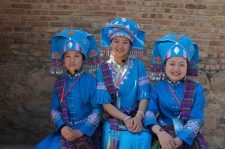
With around 18 million people, the Zhuang make up the largest ethnic minority group in China. Most Zhuang people live in the Guangxi Autonomous Zone, which is in the southeastern part of China. Other provinces with significant amounts of Zhuang people include Guangdong, Hunan, Guizhou, and Sichuan. All of these provinces border Guangxi. In Guangxi, fifty two counties are populated by Zhuang people. In nine counties, 90% of the population is Zhuang and in thirty-nine counties 50% of the population is comprised of Zhuang.
Some scholars argue that during the Song Dynasty (960-1279 AC), the Zhuang officially became recognized as their own distinct ethnic group but also during this period they would effectively become controlled by the Han Chinese. In 1958, the Chinese government designated Guangxi as the autonomous region for the Zhuang people.
Zhuang people today live in one story houses, but prior to that most of this ethnic minority group lived in unique two story houses called “stilt dwellings”, with the first floor used for storing goods and possessions while the second story housed the people. Made of bamboo and wood, the elevated homes protect the dwellers from flood and animals. Zhuang people also thought that this type of housing structure best suited the humid climate and mountainous terrain they inhabit.
The most important festival for the Zhuang people is known as the Ghost Festival. During this celebration, which takes place every year on July 14th, the Zhuang prepare sacrificial offerings of food, such as five color rice and chicken, to honor dead relatives as well as mythic heroes and heroines. Tudigong is one of these mythic heroes, whose name literally translates to that of “God of Fortunes and Virtues.” Tudigong is an elderly man with a white beard whom villagers pray to in times of drought, famine and misfortune.
A famous Zhuang story revolves around that of a nine tailed dog that was sent to heaven in order to gather grain in the time of a great drought. When the dog made it to heaven, grain stuck to each of the dog’s tails. However, a guard in heaven chopped off eight of the dog’s tails once it was discovered. The dog returned to earth with enough grain seeds to overcome the drought. Now, many Zhuang people keep dogs in their homes and feed them rice regularly.
The staple food of the Zhuang people is rice and corn. Specialty dishes of the Zhuang people includes roast sucking pig, flower sticky rice, glutinous rice cake, boiled dog meat with soy sauce, Ningming Zhuang glutinous rice dumpling, and Zhuang crisp fried chicken.
One form of clothing is that of the all black, baggy dress women are required to wear. They wear this dress along with black head scarves. This attire is all handmade.
The Zhuangs have their own language and wrote in the Chinese script until 1955, when the CCP helped create a Romanized version of their language. The CCP implemented this language improvement in order to raise educational levels of the rural ethic group. Their language originated from the Chinese-Tibetan and Tai language family. Many Zhuangs speak Mandarin and in an academic survey 55% of the total ethnic minority population speaks two languages while 43% only speak the Zhuang dialect.

